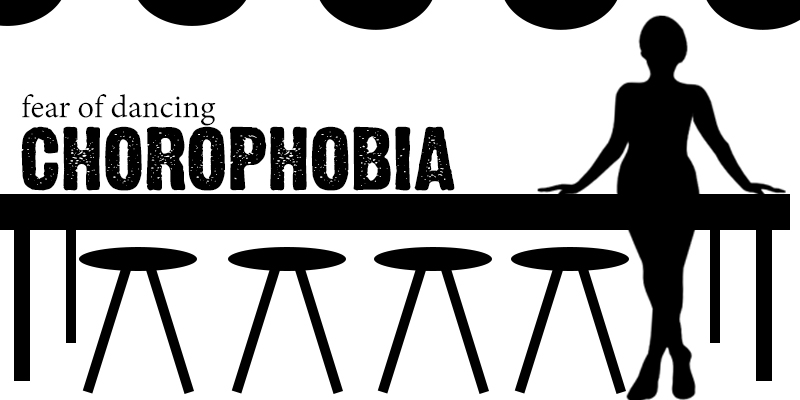Have you ever felt like a lump stuck in your throat when someone asked you for a dance? If you have, you’re not alone. In fact, many people commonly go through an unexplainable rush of fear whenever asked for a dance. Such kind of irrational and intense fear of dance is known as Chorophobia.
 Chorophobia is derived from Greek Word “Choro” meaning dance. A person having Chorophobia is fearful and extremely uncomfortable of dancing, and scared of getting excited or overjoyed. A chorophobic person is distressed of any situation, ceremony or people associated with dance. The person can be upset merely seeing other people dance in front of them. This kind of phobia is also related with another phobia of getting touched known as haphephobia or aphephobia.
Chorophobia is derived from Greek Word “Choro” meaning dance. A person having Chorophobia is fearful and extremely uncomfortable of dancing, and scared of getting excited or overjoyed. A chorophobic person is distressed of any situation, ceremony or people associated with dance. The person can be upset merely seeing other people dance in front of them. This kind of phobia is also related with another phobia of getting touched known as haphephobia or aphephobia.
What Causes Chorophobia?
Different factors seen to be likely causing Chorophobia in people are:
A Distressful Event
A phobia is always backed up by a related event which caused the distress at first place. In the case of Chorophobia too, a traumatic event can trigger this fear. A person is likely to get chorophobic if he/she had previously faced embarrassment while dancing, or faced through dress malfunctions during the performance. Any such upsetting situation can cause a person to get chorophobic.
Other Phobias and Depression
Chorophobia can be a spinoff of other specific phobias. One such phobia is the fear of getting touched known as haphephobia. Other phobias that may cause Chorophobia in a person are agoraphobia (fear of public places) and social phobia (fear of social situations). A person is also vulnerable to Chorophobia if he/she had or has suffered from depression and other mental health issues. This makes their mind weak and unable to cope up with sudden arousal and excitements.
Upbringing
The fear of dancing can also be reflected on the upbringing one has. If a child has been strictly brought up, and prohibited from dance and other such activities, he/she can be extremely fearful of dancing. In fact, he/she may see dance as a sin, and that conducting a dance act might get them punished.
The Symptoms of Chorophobia
Major symptoms of Chorophobia can be:
- Extremely fearful and conscious of dancing and places where dancing takes place
- Uncomfortable and distress by seeing other people dance as well
- Aggressive combat when asked or pressurized to dance
- Complete avoidance of places and events involving dance
- Isolation during such social situations
- Realizing that the fear is unreasonable ( except in children)
- Panic attacks with signs such as shivering, nausea and vomiting, dizziness and fainting, feeling confused, numb and getting fixed, heart palpitation, abdominal uneasiness, diarrhea, profuse breathing, sweating and clammy hands
When to Visit A Doctor?
Different social ceremonies and situations involve dancing and having fun. Chorophobic person can have extremely low self-esteem and low confidence level due to this fear. If the above symptoms have been seen for a long time, exceeding six months and have kept you from involving in social events, you need to consult a doctor.
How Is Chorophobia Treated?
Chorophobia can be treated using different psychotherapies. In severe cases of panicking, medications may also be used.
Exposure therapy with Relaxation
Exposure therapy is a very effective psychotherapy used to slowly reduce the fear and anxiety associated with dance. The therapist sets a scene where the person has to dance, or related pictures and movies, and studies how the person reacts. Then, the person is regularly exposed to such scenes and taught to relax oneself slowly. The therapist teaches various relaxation methods such as breathing control, muscle release exercise and mind visualizations which are to be used during the exposure sessions. Eventually, the person will be able to tolerate the fearful feelings.
Cognitive Behavioral Therapy (CBT)
CBT is another effective psychotherapy used for treating Chorophobia. It is aimed at digging out the root causes responsible for the occurrence of such phobia. Generally, these are negative thoughts and behavioral traits associated with dance. The therapist conducts regular counseling sessions to modify these negative thoughts into positive ones, and build an appropriate behavior.
Sometimes, a therapist may also use hypnotherapy i.e. hypnosis to recognize underlying negative thoughts and images within the subconscious mind of a person.
Medicines
In serious cases of panicking, medications may also be used to control the fear and anxiety. Commonly used medicines are anti-anxiety and anti-depressant medicines to balance brain chemicals such as Serotonin. They help to being the symptoms under control.